
3DPRINTINGINDUSTRY.COM
Mighty Buildings Up for Sale Following Headcount Reduction
Construction 3D printing company Mighty Buildings is up for sale. The California-based firm, which 3D prints eco-friendly houses, announced the listing following a restructuring that also saw an undisclosed number of staff members laid off.According to a LinkedIn post by Jennifer A. Farley, the companys Chief People, Legal & Business Operations Officer, former Mighty Buildings employees with expertise in operations, supply chain, sales, engineering (structural & mechanical), quality, architecture, material science, finance, legal or HR in the US, Mexico or Europe, are now looking for work.This could be considered surprising for an entity that has raised over $150 million and attracted investment from more than 100 Silicon Valley and global shareholders.Rock Creek Advisors is managing the 4-week sales process, with a final term sheet deadline of February 14th, 2025, at 5 pm ET. While cash bids are preferred, the New Jersey-based investment firm will consider all reasonable offers.Mighty Buildings assets can be purchased as a package or individually, with patents, trademarks, expertise, manufacturing equipment, and strategic partnerships all up for grabs. Ultimately, the construction 3D printing specialist hopes to attract a partner or financial buyer capable of scaling the business and driving future commercial success.Mighty Buildings first 3D printed net-zero energy home. Photo via Mighty Buildings.3D printing sustainable homesFounded in 2017, Mighty Buildings launched from stealth mode in 2020 after developing proprietary construction 3D printing technology and raising $30 million in funding.Through its production-as-a-service business, the firm specializes in 3D printed homes that are efficient, cost-effective, and sustainable. Its modular, 3D printed panels can be quickly assembled on-site, accelerating development times by 3X.Central to the companys extrusion-based production method is its in-house developed 3D printing material. Lumus, the latest generation of this composite stone feedstock, reportedly offers 80% lower CO2 emissions compared to conventional concrete. Mighty Buildings unique material can harden almost immediately after UV post-curing while still maintaining cohesion with its underlying layers. This freezing ability allows ceilings and overhangs to be fabricated without support structures.The companys automated 3D printers can run for 24 hours a day and assemble multiple buildings simultaneously. This process reportedly produces just 1% of the waste generated by conventional construction processes.Significantly, Mighty Buildings gained UL 3401 certification, an important construction safety qualification, before exiting stealth mode. This safety-mindedness has seen the firm prioritize the production of climate-resilient homes. These buildings can withstand 300 kph hurricanes, earthquakes, and up to two hours of exposure to fire.Mighty Buildings modular, 3D printed panels. Photo via Mighty Buildings. Mighty Buildings previous successMighty Buildings has raised substantial capital through several funding rounds. The latest, completed in September 2023, saw the firm raise $52 million to expand its construction 3D printing capabilities.This was co-led by Waed Ventures, the innovation-focused venture capital fund supported by Saudi Aramco, and US venture firm BOLD Capital Partners. Alongside them, nearly 20 investors participated, including Khosla Ventures and KB-Badgers, a South Korean fund centered on advanced manufacturing, automation, and sustainability.Previous funding rounds included $22 million in July 2021 and $40 million in February 2021. This capital was used to advance the companys carbon neutrality roadmap, generate new strategic supply chain partnerships, and expand its team.In addition to substantial financial backing, Might Buildings has several notable projects and partnerships to its name. Last year, the sustainable housing developer collaborated with manufacturing conglomerate Honeywell to integrate its eco-friendly Solstice Liquid Blowing Agent (LBA) insulation into 3D printed buildings. LBAs global warming potential is 99.9% lower than conventional blowing agents. It also provides superior thermal insulation than foam alternatives, meaning the 3D printed homes require less energy for heating and cooling.Previously, Mighty Buildings delivered the first 3D printed net-zero energy home. Assembled from a set of 3D printed panels, the two-bed, two-bath house became the first addition to a new neighborhood in Southern California. This followed the companys plans to build a community of fifteen 3D printed eco-friendly houses near Coachella Valley.Featured image shows a render of Mighty Buildings proposed fifteen-strong 3D printed housing community. Image via Mighty Buildings/EYRC Architects. Additive manufacturing for constructionA recent UN Environment Programme report outlined that the construction and building industry is responsible for 37% of global greenhouse emissions. According to Mighty Buildings, $180 billion of cement is used annually for residential construction, while the US housing market is currently short 6.5 million homes. This has led to the growing adoption of construction 3D printing technology, which offers sustainability and cost benefits.Earlier this month, Harcourt Technologies Ltd (HTL.tech) completed Europes first 3D printed social housing project, utilizing technology compliant with the ISO/ASTM 52939:2023 standard. Based in Grange Close, Ireland, the homes were built using COBOD Internationals BOD2 3D construction printer. The project was completed in just 132 days, a 35% reduction compared to traditional construction methods, which typically take over 200 days.Similarly, Texas-based construction 3D printing firm ICON announced last year that it was building a new housing development in Wimberley Springs. Located 40 miles south of Austin, the neighborhood includes eight single-family 3D printed homes. These will feature high-thermal performance concrete, maintaining stable indoor temperatures without significant heating or cooling costs. Certified to the EnergyStar standard, the houses will typically achieve a Home Energy Rating System (HERS) rating of 40-55. This makes them 45-60% more energy-efficient than conventionally constructed alternativesWho won the 2024 3D Printing Industry Awards?All the news from Formnext 2024.Subscribe to the 3D Printing Industry newsletter to keep up with the latest 3D printing news.You can also follow us on X, like our Facebook page, and subscribe to the 3D Printing Industry Youtube channel to access more exclusive content.Featured image shows a render of Mighty Buildings proposed fifteen-strong 3D printed housing community. Image via Mighty Buildings/EYRC Architects.
0 Comments
0 Shares
173 Views


